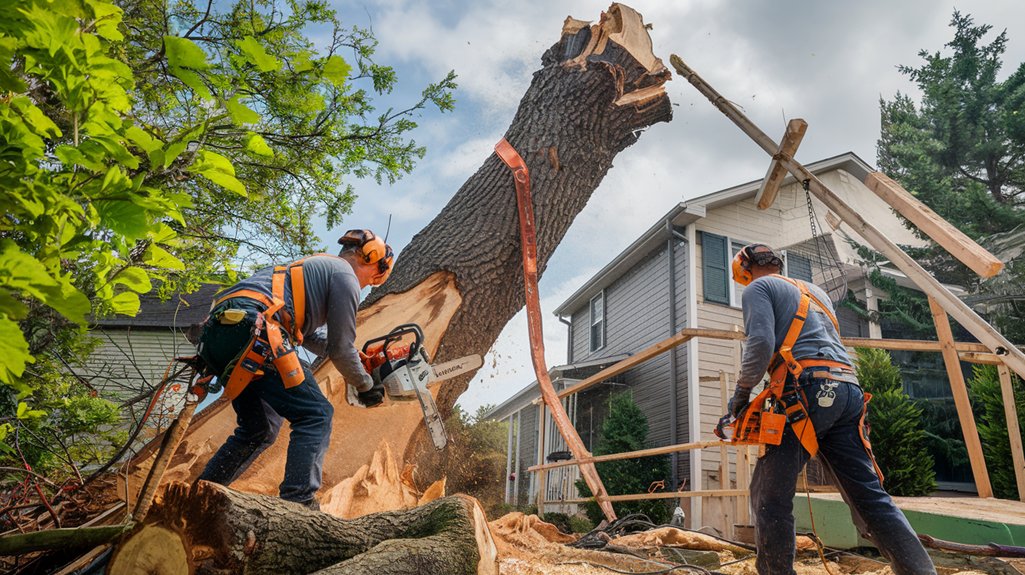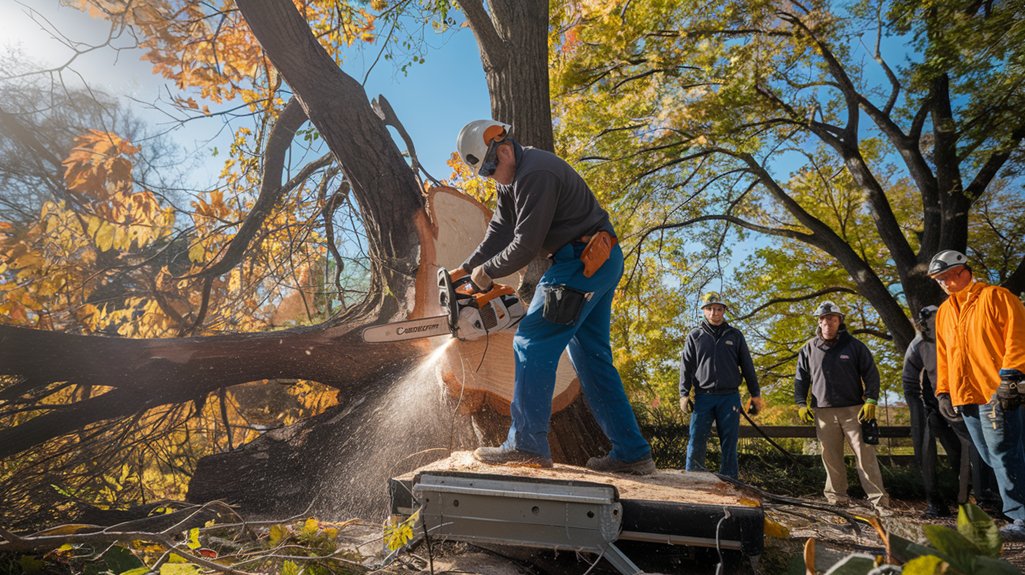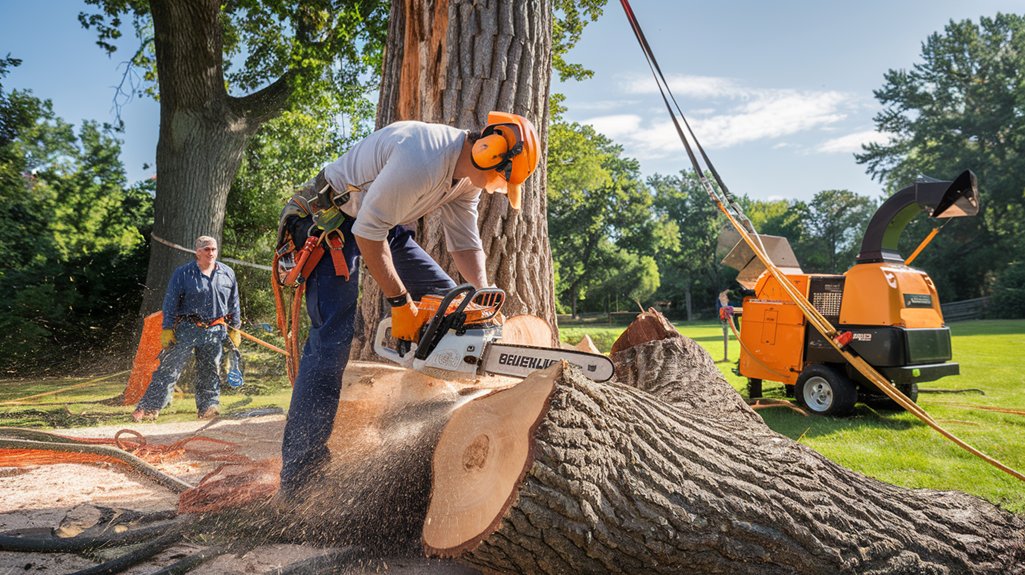When it comes to tree removal, recognizing hazardous trees is just the beginning. You might notice signs like leaning trunks or dead branches, but understanding the risks these trees pose is crucial. That’s where professional expertise comes in. They know how to assess and handle dangerous situations safely. So, what exactly does the removal process involve, and how do experts ensure everything goes smoothly? Let’s explore the essential steps involved in tree removal done right.
Key Takeaways
- Professionals conduct thorough risk assessments to identify hazardous trees and determine the best removal strategies.
- Specialized equipment, like chainsaws and stump grinders, ensures safe and efficient tree removal.
- Directional felling techniques are employed to guide the tree’s fall, minimizing damage to surrounding areas.
- Safety protocols, including proper training and communication, are essential to protect workers and property during the removal process.
- Post-removal cleanup is performed to maintain safety and tidiness, ensuring the site is free of debris.
Understanding Hazardous Trees: Signs and Risks

When you look at a tree, it might seem harmless, but some trees can pose serious risks to your property and safety. Understanding tree health is crucial for identifying hazardous trees.
Look for signs like leaning trunks, dead branches, or fungal growth, which can indicate decay. Conducting a risk assessment helps you determine whether a tree might fail during strong winds or storms.
If you notice roots lifting or cracks in the trunk, it’s time to take action. Regularly monitoring your trees and being aware of their condition can save you from costly damage and potential injuries.
Don’t wait until it’s too late; prioritize tree health to ensure your surroundings remain safe and secure.
The Importance of Professional Expertise in Tree Removal

Identifying a hazardous tree is just the first step; removing it safely requires professional expertise. You need trained professionals who understand tree health and can perform a thorough risk assessment.
They can evaluate the tree’s condition, considering factors like stability, decay, and proximity to structures or power lines. Without this expertise, you risk endangering yourself, your property, and even nearby trees.
Professionals use their knowledge to mitigate hazards and ensure that the tree is removed in a controlled manner. They’re familiar with local regulations and best practices, which can save you from legal troubles down the line.
Equipment and Techniques Used by Tree Removal Experts

Effective tree removal relies heavily on the right equipment and techniques. When tackling hazardous trees, professionals use specialized tools like chainsaws and wood chippers for efficient tree cutting. These instruments allow for precise cuts, minimizing risk and ensuring safety.
Heavy machinery, such as stump grinders and aerial lifts, is also essential, especially for large or unstable trees. With the right equipment, experts can assess the tree’s condition and determine the safest removal method.
They employ techniques like directional felling, which helps guide the tree’s fall, reducing damage to surrounding areas. By utilizing advanced equipment and techniques, tree removal experts ensure a smooth, safe process that protects both themselves and your property.
The Tree Removal Process: Step-by-Step
Removing a tree involves a clear, systematic approach to ensure safety and efficiency. First, you’ll conduct a thorough tree assessment, identifying any hazards, the tree’s health, and its surroundings. This assessment helps you determine the best removal strategies.
Next, you’ll prepare the site by clearing the area of obstacles and ensuring a safe zone for workers and bystanders.
After that, you’ll choose the right equipment based on the tree’s size and location. You’ll then execute the plan, starting with cutting branches and working your way down to the trunk.
Finally, once the tree is down, you’ll clean up the debris, ensuring the area is safe and tidy. Following these steps guarantees a smooth and effective tree removal process.
Safety Protocols for Tree Removal Operations
When you’re planning a tree removal operation, prioritizing safety is essential to protect everyone involved. Start with a thorough risk assessment to identify potential hazards like nearby structures, power lines, and unstable ground. This assessment helps you create a comprehensive safety plan tailored to the specific site.
It’s also crucial to ensure all team members undergo proper safety training. This training should cover equipment use, emergency protocols, and personal protective equipment (PPE) requirements. Make sure everyone understands their roles and responsibilities during the operation.
Establish clear communication channels, so everyone stays informed and alert. By implementing these safety protocols, you can significantly reduce risks and ensure a smoother, safer tree removal process.
Prioritize safety, and you’ll protect both your team and the surrounding environment.
Post-Removal Care and Landscape Restoration
After a tree’s been removed, taking the right steps for post-removal care is crucial to restore the landscape and promote healthy growth.
Start by assessing the soil health—test for nutrient levels and compaction. If necessary, amend the soil with organic matter to encourage new plant growth.
Next, consider your landscape design; think about the plants you want to introduce. Choose species that complement your existing plants and thrive in the area.
You might also want to fill in the space with mulch to prevent erosion and retain moisture.
Finally, monitor the area for any signs of pests or diseases, ensuring your new landscape flourishes.
With careful attention, you can create a vibrant, healthy environment after tree removal.
Frequently Asked Questions
How Much Does Professional Tree Removal Typically Cost?
Professional tree removal costs usually range from $200 to $20,000. Factors influencing this include tree size, location, and accessibility. It’s wise to get multiple quotes to find the best price for your needs.
Can I Remove a Tree Myself if I Have Experience?
If you’ve got experience, you can remove a tree yourself. Just remember to follow safety precautions during tree cutting, like wearing protective gear and ensuring a clear area. Always prioritize your safety and that of others.
What Permits Are Required for Tree Removal?
Before removing a tree, check local regulations for tree removal permits. You might need to apply for one, especially if the tree’s size or location affects public safety or environmental concerns. Always confirm requirements beforehand.
How Long Does the Tree Removal Process Usually Take?
The tree removal timeline can vary significantly. Factors affecting duration include tree size, location, and accessibility. Typically, it takes a few hours to a day, but more complex situations might extend that timeframe.
What Happens to the Tree After Removal?
After removal, you’ll choose from various tree disposal methods, like chipping or hauling away. For the stump, you’ve got options too, such as stump grinding, which effectively eliminates any remnants left behind.
Conclusion
In conclusion, when it comes to tree removal, trusting professionals is key to safety and efficiency. They know how to spot hazardous trees and use the right equipment and techniques to handle the job. By following strict safety protocols and ensuring proper post-removal care, they help restore your landscape while minimizing risks to your property and loved ones. So, when you’re facing a tree-related issue, don’t hesitate to call in the experts for peace of mind.
